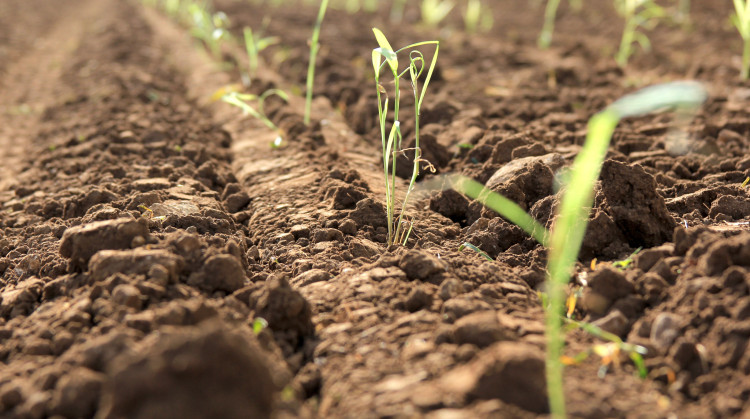Miscanthus: Endless Opportunities

Terravesta's science team is dedicated to developing new outstanding Miscanthus hybrids for specific sustainable end-markets. This month we speak to Jason Kam, our research and development manager, about some of the exciting things in the pipeline…
What do you think is the scope for Miscanthus and why should people be excited about it?
The end-product opportunities are endless. From biofuels, to building materials and packaging, and crucially, Miscanthus is an environmentally-friendly material which can be designed for many viable and sustainable end-uses.
Miscanthus also offers very unique opportunities in terms of biomass quantity as well as quality. As many owners of biomass boilers (private or industrial) would testify, Miscanthus (particularly Terravesta AthenaTM), has lower ash content than wheat straw making the operational time shorter between clean up.
A lot of the work we are doing behind the scenes is paving the way to develop new varieties for a rapidly emerging bio-economy.
What exciting projects are you working on at the moment?
GRACE and Miscomar + are both ground-breaking projects.
GRACE
GRACE stands for “GRowing Advanced industrial Crops on marginal lands for biorEfineries”. It’s a cross-European project that includes over 20 different organisations, both in academia and industry, identifying commercial uses for Miscanthus and Hemp.
It’s a ground-breaking project, where science meets sustainable commercial opportunities.
It covers plant physiologies and developments all the way to end-products, and through this we are working closely with other innovative European partners developing fantastic opportunities to grow the Miscanthus bio-economy.
Terravesta’s role in GRACE has been very significant, particularly in the beginning. We’ve been supplying planting materials in multiple locations in Europe (e.g. UK, Poland, Germany, Italy and Croatia etc). We have also provided planting material in the UK, allowing our study to be extended to commercial scale.
Not only is Terravesta providing planting material, we have also managed field trials as well as directly contributed to data collection in our UK and Polish sites. This gives us an opportunity to study our product in cultivation in other European countries that have very different climates.
Find out more about GRACE here.
Miscomar +
Miscomar + (MIScanthus biomass options for COntaminated and MARginal land: quality, quantity and soil interactions) is a Defra, and other European counterparts for our European collaborators, funded project. We have been invited to be a partner, and we are supplying planting material and participating in the study.
The project will test for Miscanthus’ ability to grow in these unfavourable contaminated soils as well as its potential to either take up or exclude heavy metal.
It will give us access to the soil and plant chemical analysis as well as growth data on this contaminated land. In the previous project related to this, Miscanthus has been doing remarkably well in contaminated soils. Now that we have new hybrids as well as matured crops from the previous hybrids, it will be a good opportunity to have more data to help build our understanding of our products.
Could you talk us through some of the exciting international trials taking place?
It’s Terravesta’s ultimate goal to offer a broad enough portfolio of new Miscanthus Hybrids (both rhizome and seed based) to consistently deliver competitive high yields at any latitude globally.
To turn this into reality, we need empirical data gained through a well-managed global programme of trials. Our journey outside the UK started in earnest with trials established across Europe through our network of partners within GRACE.
The overwhelmingly positive performance data emerging from the majority of these European trials has given us the confidence to start assessing the performance of selected varieties in various locations in the Southern hemisphere with strategic partners, where logistics challenges in rhizome deployment has largely prevented the viability of Miscanthus to date.
Early data from these trials suggests a very exciting pathway ahead.
Furthermore, the flow of innovation into the global bio-economy has never been greater than now, with a wave of new bio-based industries emerging on a global scale.
Terravesta’s world-class capabilities in Miscanthus have resulted in our involvement as a principal supply-chain partner in a growing number of commercial bio-based activities across Europe and more recently, the US and Africa. As always, all of these activities must start with trials to ensure we retain our reputation consistently delivering on world-class service and quality in Miscanthus.
What progress has been made with new Miscanthus hybrids?
Two of our most promising seed-based varieties are now in the final year of pre-commercial trials to validate both our propagation and planting processes ahead of scaling to commercial readiness.
All being well, we are confident limited volumes of both varieties will be available to a selective market in the UK in 2021, with a full support programme available to establish these varieties.
What makes these varieties special is their versatility to be used in a variety of emerging markets from furniture through to 2G bio-refinery processes where optimum yields can be achieved due to increased hemicellulose content.
Are there any recently published studies which you feel highlight some interesting research?
There are quite a few recent publications but the most relevant is Rebecca Wilson’s PhD thesis on producing the “Perfect Plug” by. Dr (or soon to be as she has passed her viva) Rebecca Wilson, who is a PhD student supported by Terravesta.
We are proud of her achievement and our involvement with her scientific endeavour. This particular is timely as we are gearing up ourselves in testing different way to increase the resilience of our plugs so that we can offer our customer the best plug possible at a reasonable price. Much of our research target will be based on the experience learnt from this publication.
What is the potential for bioplastics and what progress has Terravesta made here?
Plastic is polymer usually made from petroleum, using naphtha as raw material. Depending on their molecular structure, they can have different properties with different molecules forming a molecular chain.
The five most common plastic polymers would be: Polyethylene Terephthalate (PET), High-Density Polyethylene (HDPE), Polyvinyl Chloride (PVC), Polypropylene (PP) and Low Density Polyethyene (LDPE). They can be made flexible or rigid.
However, as we know, the problem with the majority of the plastics is that they rely on petroleum for raw materials and there are a very limited number of organisms in nature that can break them down.
By using a plant-based polymer, products would retain durability for the prescribed duration, while the existence of natural organisms would break down these polymer, and we wouldn’t have to rely on petroleum.
We have been trying different biodegradable plastics in the GRACE project in the form of agricultural film and with various degrees of success, and this work is currently in process.
This article was originally published on Terravesta's website.






